Animal Cruelty - Animal Testing
[WARNING: Pictures may be disturbing.]
The FDA no longer requires all drugs to be tested on animals before human trials | January 12, 2023 - NPR
U.S. Government testing facilities and a sampling of major links can be found on this page.
Global Digest has an extensive and comprehensive section on: Animal Cruelty -- Animal Testing.
Simply stated, the purpose of this exercise is to raise awareness about the cruelty forced upon other animals by humans. I use the word force because, given the choice, I don't think any of them would volunteer. What's the common denominator? What do all the ways we have of inflicting physical, emotional, and psychological pain and suffering on other species share at root? From thousands watching dogs attack a defenseless, tethered bear for entertainment, to shampoo put into the eys of a rabbit or monkey to test its causticness, to forcing a dog or cat to ingest pesticide or some household cleaning agent to see what happens, to poaching an animal whose uniqueness is on the verge of extinction for money and imaginary medicine or sculpted trinkets. Are the motives for these and all the other ways we know to exploit other animals different in fact, or not?
We are the superior beings, we believe. We have the right by birth to use other creatures for whatever we wish, in whatever way we wish. For our health and well-being, for appearances, for entertainment, for personal pleasure, to bolster our precious ego, to mass-produce food efficiently on factory farms, for money. The list goes on. It's an attitude that cuts us off from the life of the planet. It's long overdue time for a correction, a revolution of the heart and mind. Not based on sentimentality, but on necessity.
When does abuse become cruelty? Is any abuse cruelty? Are there questions of degrees of abuse like when a child is reprimanded for misbehaving according to some arbitrary rules that an outsider, judging soley on an innate notion of when a punishment fits the crime, might see as excessive? When does abuse become cruelty? Is this situation a matter of cultural context only, of ingrained feelings and thoughts inculcated through socialization, a moral frame of reference insulated from outside criticism by pure will and right to sovereignty? Or is cruelty and its perception a question of consciousness, of common sense, of empathy and their work on growing a conscience?
These are questions for philosophers and psychologists and social workers. They're far too general and tend to confuse and dilute the real issues of animal cruelty, its root causes and unconscious beliefs. The vast majority of us know what cruelty is, we see it everyday on the news and in our personal life. Even though in any given population there is a general consensus on where that line lies--what constitutes cruelty--it varies for each of us at different times and places in our life and under different circumstances. Does that mean its assessment is completely relative? Perhaps. Nonetheless, if it's blatantly obvious, we can't help but admit it; whether we care or not, we still know. We can point and say, "that's cruel." But we've learned to ignore it, to steel ourselves, to suppress our gut reaction. We're taught it's for the common good, or for the good of some like-minded group; it's how things are done and that's the way it is.
How much pain is too much? Well, that depends on the victim; how much can he take? If the victim can't speak for himself, who decides? Do the ends justify the means?
Is cruelty to animals in the eyes and feelings of the beholder only? Or can an objective criterion be established that effectively and unequivocally specifies the essential ingredients constituting animal cruelty? Beyond the obvious, I don't think either is possible. That is, there is neither a strictly subjective nor objective criterion. But, it would seem, that by first recognizing animals as capable of experiencing emotions and pain, of possessing states of mind and moods, of being individuals, it might be easier to empathize.
We believe that to cure diseases and prevent their spread, discover a vaccine, we need to experiment on some living thing. The closer to our anatomy and make-up, the better; although, almost any creature will do for specific research. Internalized as an a priori necessity--it has to be this way--the popular acceptance and government-backed legitimacy underlying that belief gives it rationality and justification. Ultimately, it bears the same authority as a general principle of the universe.
Our respect for and treatment of other living things represents a benchmark for how far our civilization has developed. An alien race on a survey mission might see past our self-delusional veneer of sophistication to focus instead on our attitude towards the planet. A so-called sentient species polluting the atmosphere and the finite supply of water, cutting down the oxygen-enriching forests (habitat), plundering the natural resources, killing and torturing animals in the name of science (cosmetics?), for pleasure (ivory trinkets and bragging rights), for entertainment (bear baiting, dog fighting), and for superstitious medical reasons might very well be perceived as invaders from another world. Along with endless wars, conflicts, genocide, slavery, torture, and the occasional mass murder, it seems reasonable that first contact might not be all that desirable.
We are the top predator in the valley--we have the technology--but that's not what makes us human.
Obviously, the pictures below are intended to evoke shock, outrage, sympathy, and shame, but that doesn't invalidate them. They speak for themselves, blatant and true.
I wanted to include the following by Marc Bekoff for anyone who may harbor misconceptions about the inner nature of animals. Compassion and empathy can only be deepened by a more thorough understanding. They are individuals and more than animate objects.
Judge Denies Envigo’s Motion; All 4,000 Surviving Beagles May Soon Be Bound for Adoption | July 1, 2022 - PETA
4,000 Beagles Are Being Rescued From a Virginia Facility. Now They Need New Homes. | July 12, 2022 - The New York Times
Why are Beagles used in Lab Experiments, Research and Testing? | Beagle Care
Marc Bekoff, PhD
Grim news for bears, tigers under proposed new wildlife law in China
January 30, 2016 - The Washington Post
Animals used in traditional Chinese medicine are tigers, leopards, sharks, saiga antelope, elephants,
rhinoceros, pangolins, tortoises, seahorses, musk deer, as well as 7 of the 8 species of bear.
Tiger bones have been a common ingredient in traditional Chinese medicine for centuries because of the belief that they strengthen the body. Despite the fact that they have been removed from all ingredient lists throughout the country, there is still a demand for them among the wealthy. The industry has reduced the tiger population in China from 100,000 to a mere 3,000 over the course of the last century.
There are an estimated 500 tiger farms in China, as well as an unknown number of bear-bile farms. The tigers are raised for their hide and body parts.
PETA Reveals Hen Hell at Egg Supplier to Tokyo Olympics
A new PETA video exposé of Japan’s largest egg producer, ISE Foods—which is certified to supply the Tokyo Olympics—reveals hell on Earth for hens. ISE Foods claims that its eggs are “so fresh … that they can be eaten raw,” but PETA’s footage shows what conditions are really like on ISE’s factory farms.
Harvard Experimenter Continues Depraved Legacy of Britches’ Tormenter
What Is Ag-Gag?
"The meat industry is waging an all-out war on your right to know where your food comes from. Whistleblower investigations routinely expose horrific animal abuse at factory farms and slaughterhouses. Yet rather than improve conditions, the meat industry is trying to silence whistleblowers by passing “ag-gag” laws. These dangerous laws violate our constitutional rights and threaten animal welfare, food safety, workers’ rights, and the environment."
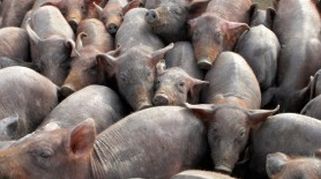




The pigs on the left are in "gestation crates." The ones on the right are on a research farm
that rears pigs intensively. It includes sows in stalls and piglets in slatted floor pens.
All pigs are kept in completely barren pens.
Got Misery? Milk Does | Video - Pictures | Petition
Is your milk and cheese the product of blatant animal cruelty?
Tell Congress: Protect the whistleblowers who expose abuse in factory farms | Credo Action
"Most chickens raised on factory farms have less than an iPad’s worth of space. They live by the tens of thousands in warehouses, on top of their own waste, never seeing sunlight. Bred to grow four times faster than just 50 years ago, they’re crippled by their own weight and struggle to move or walk. The industry is getting away with this in large part because consumers don’t know the inhumane, unhealthy conditions behind the product they’re purchasing."
--- ASPCA
So you like chicken, do you? Here is a video of an undercover investigation of Tyson Foods by Mercy for Animals:
Mercy for Animals Slams Tyson over Tortured Chickens | June 1, 2016MFA's Undercover Investigations
Chinese donkey skin trade remains a serious threat | Network for Animals
End Bear Bile Farming | Peace Fur Paws
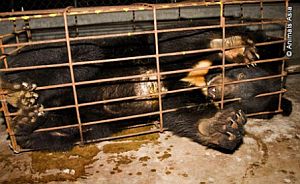
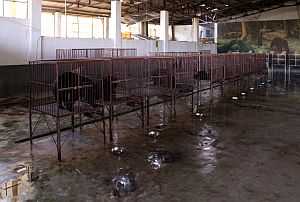

Of all the despicable cruelties inflicted on animals by people, bear-bile farming tops the list in my book. It's legal in China and South Korea, and in Vietnam remains widespread despite being illegal. The practice bespeaks of the cold-bloodedness and superstitious nature of the Asian peoples. They live in their own parallel universe where common sense, empathy, compassion, and respect for nature and its creatures are hardly considerations. Moreover and to the point: Bear bile is not a necessary commodity for anything.
"Bear bile has been used in traditional Asian medicine for thousands of years. It contains high levels of ursodeoxycholic acid (UDCA) known to be useful for treating liver and gall bladder conditions. However, there are now many readily available herbal and synthetic alternatives with the same medicinal properties."
Animals Asia
|
Is the end of 'house of horror' bear bile factories in sight?
April 9, 2015 - The Guardian
Folk Remedy Extracted From Captive Bears Stirs Furor in China
May 21, 2013 - The New York Times
End the Bear Bile Industry - World Animal Protection
Animals Asia | Our Work - The Issue
Five Things You Need To Know About Bear-Bile Farming
Recent News | Animals Asia Foundation
Bear bile replacement breakthrough in China | August 6, 2015
BREAKING NEWS: Vietnam agrees plan to close all bear bile farms | July 19, 2017
Meet the 17 bears you saved in 2017, and other highlights... | Video
Bear bile farming to be eradicated in Vietnam by 2020 | September 21, 2015
The 14 Worst ‘Festivals’ Still Taking Place Today | PETA
The Mexican Town That Bashes Piñatas Full of Live Animals
Yucatan celebrates four consecutive years of a cruelty-free fiesta | Humane Society International

STOP BOKNAL, THE SOUTH KOREAN DOG MEAT FESTIVAL | Care2Petitions
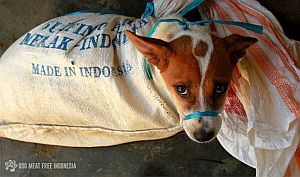
End Yulin Festival - End the Dog Meat Trade - Sign Our Letter | AnimalsAsia
Chinese City Defends Dog Meat Festival, Despite Scorn
June 23, 2015 - New York Times
City Aims to Play Down Its Dog Meat Festival
June 17, 2014 - New York Times
"China does not have animal cruelty laws, and there is a history of
eating dog meat, particularly in far southern and northern regions."
Yulin Dog Meat Festival Provokes Global Fury
June 22, 2015 - Humane Society of the U.S.
Yulin Update 22.06.15 | Animals Asia Foundation
Secret cameras capture preparations for China's barbaric annual meat festival as tensions
mount between traders and animal rights' groups ahead of tomorrow's official launch
June 21, 2015 - The Daily Mail
 ||
||  ||
|| 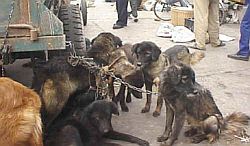 ||
||

"The Chinese region of Yulin is already preparing for their annual summer solstice dog-eating festival. Each year, thousands of festival-goers consume dog meat en-masse with lychee and grain alcohol as part of a decades-old tradition. In 2014, an estimated 10,000 dogs were killed for the festival, most of which were bred for slaughter but some of which were lost or stolen pets. Animals were brought from all over China to supply the festival’s high demand for dog meat."
-- Animal Petitions
Petition: SIGN our open letter to China to END the dog and cat meat trade | June 1, 2017 - Animals Asia
"This year on June 22, the southern Chinese city of Yulin will host its now infamous dog meat festival. But this is no festival. In just one day, up to 2,000 dogs will be slaughtered, all in the name of profit."
-- Animals Asia

Stopping Yulin, stopping the dog meat trade | Animals Asia
10,000 Dogs Tortured as Part of Annual Yulin Dog-Eating Festival
April 29, 2015 - The Dogington Post
China Dog Meat Festival 2014: 10,000 Dogs to be Slaughtered at Yulin Summer Solstice Celebration
June 9, 2014 - International Business Times
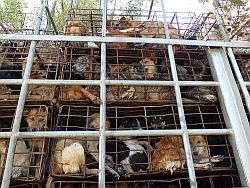
Watch: "Shadow Trade - The Price of Loyalty" | Documentary
‘Shadow Trade - The Price of Loyalty’ is a documentary that exposes the illegal dog meat trade in Thailand.
It follows the tragic story from the streets where dogs are stolen,
across The Mekong and into Vietnam where they are slaughtered.
600 Stray Cats Bolied Alive | May 26, 2015 - Blog - Koreandogs.org
South Korea: Punish the Man who Boiled Alive 600 Stray Cats with Prison Sentence!
"Busan Bukbu Police arrested 54-year-old “Mr. A” on charges of capturing and slaughtering 600 live stray cats, which is a violation of South Korea’s Animal Protection Act. During the raid at Mr. A’s slaughterhouse, 18 cats were discovered locked in a crate and waiting to be killed. Mr. A has admitted to boiling, killing and selling over 600 stray cats, which seems like an unfathomably high number, but the police explained that there is a high demand for cat soup due to a niche belief that the soup cures or alleviates symptoms of arthritis."
-- Animal Petitions
Stop Animal Cruelty | Supreme Master Television
"The images in the following programs are very sensitive and may be as disturbing to
viewers as they were to us. However, we have to show the truth of animal cruelty."
Animal Petitions Educational Series: Animal Testing
More than 115 million animals, worldwide, are used for experimentation and biomedical research every year. In the US alone, 70,000 dogs are used for research testing every year, of which 96% are beagles because of their docile temperament and trusting nature.
Rise for Animals
Activists Pressure Petco to Cut Ties with Animal Cruelty | Rise for Animals
Cruelty Free International
Habitat for Horses
DONKEY HIDES BELONG ON DONKEYS | Habitat for Horses
Animals Testing and Experiments FAQ | Humane Society
Facts and Statistics About Animal Testing | Peta
Animals Used for Experimentaion by the U.S. Department of Agriculture
USDA’s Meat Animal Research Center: An American Horror Story | ASPCA
"The United States Department of Agriculture has been secretly conducting inhumane animal testing and cruel breeding practices. At the U.S. Department of Agriculture’s Meat Animal Research Center (USMARC), countless animals are tested on and put under unthinkably deplorable breeding conditions to provide meat producers with methods on how to make more money from their livestock.
"According to an ongoing investigation by The New York Times, USMARC is responsible for scientifically altering the breeding capacity and output of pigs, which leads to unnaturally large litters and piglets being crushed to death by the weight of their hormone-injected mothers. They’ve genetically modified the natural breeding process of cows, forcing them to give birth to twins or even triplets when they usually bear one calf at a time, resulting in weakened and deformed calves. Plus, they’ve conducted inhumane tests on young lambs by leaving them in open fields during severe weather, and even in the presence of predators, just to see if they could survive without human help."
-- Animal Petitions
USMARC: U.S. Meat Animal Research Center - USDA
U.S. Research Lab Lets Livestock Suffer in Quest for Profit
January 19, 2015 - by Michael Moss - The New York Times
Outrage Over Government's Animal Experiments Leads To USDA Review
February 6, 2015 - by Allison Aubrey | NPR
USDA's Meat Animal Research Center: An American Horror Story
January 23, 2015 - by Mathew Bershadker (ASPCA President and CEO) - Huffington Post
Terrible Conditions Uncovered at US Animal Center
January 26, 2015 - Network for Animals
Government and Professional Resources | USDA
This page provides information on federal laws, and regulations that govern animals
used in research, testing, teaching, and exhibition. It also provides animal welfare
guidelines, policies and codes of practices from around the world.
Animal Testing and the Law | Animal Legal Defense Fund
NAVS: National Anti-Vivisection Society
Animals and Product Testing
NEAVS: New England Anti-Vivisection Society
NEAVS works nationally and internationally to replace the use of animals in research,
testing, and science education with scientifically superior and humane alternatives.
What is Vivisection?
What does "vivisection" mean? | FAQs
Animals in Research - Harm and Suffering
Retire Privately "Owned" Chimpanzees Now
Websites of four labs still holding chimpanzees at bottom of page.

Stop Breeding Dogs for Drug Testing and Vivisection | July 20, 2015 - Animal Petitions
"Dogs used in scientific experiments are forced to inhale toxic substances through masks,
are strapped in harnesses so that they can’t escape for drug injections, and force fed through tubes.
Popular substances tested on dogs include pharmaceutical drugs, weed killer, and industrial chemicals."
Stop Deadly and Cruel Experiments on Dogs
At a research lab at Texas A&M University, golden retrievers are bred
with painful muscular dystrophy and spend their lives being experimented on.

Disturbing Footage Shows A&M Dogs Used in Medical Research [UPDATED]
A Lab Dog's Painful Life: Thousands of Man's Best Friends Still Used for Research | Observer
Urge Texas A&M University to Close Dog Laboratories | PETA
Texas Animal Cruelty Laws
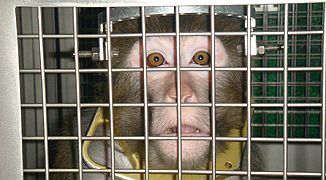
The University of Utah Must Stop Its Rogue Animal Experimenters | PETA
PETA has uncovered new documents showing that experimenters at the University of Utah flagrantly violated animal welfare laws—again.
Dogs Bred to Suffer and Waste Away in Labs | Campaign - PETA
You won't believe what's going on at some colleges in the US.
Behind the Locked Doors of U.S. and French Dog Laboratories | PETA
Dog Experiments at Wayne State University | Physicians Committee for Responsible Medicine
Billboard Confronts Wayne State over Experiments on Dog Named Madonna
"Heart failure was artificially induced in Madonna by surgically implanting pacing wires in her heart
and forcing it to beat faster than normal. Experimenters implanted numerous devices into her body and
compelled her to exercise on a treadmill. Madonna was later killed."
Why the U.S. Won't Ban Cosmetics Animal Testing Anytime Soon | Fashionista
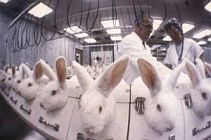


Fact Sheet: Cosmetic Testing | The Humane Society of the United States
"Examples (of cosmetics) include skin cream, perfume, lipstick, nail polish, eye and facial makeup,
shampoo, and hair color. Any ingredient used in a cosmetic also falls under this definition."
Creating a Cruelty-Free World - Ending Animal Testing for Cosmetics | HSI
Humane Cosmetics Act Reintroduced: Ask your rep for support! | June 23, 2015
H.R. 2858: Humane Cosmetics Act | Govtrack.us
Prognosis: 3% chance of being enacted. There have been no votes related to this bill.

The Company for Cruelty? | Snopes
The Truth Abut China's New Animal Testing Laws

Animal Cruelty Worldwide
Animal Cruelty in Research Labs
Inside the Animal Labs | Gateway to Hell
Understanding Animal Research
"Understanding Animal Research aims to achieve broad understanding and acceptance of
the
humane use of animals in biomedical research in the UK, to advance science and medicine.
The information provided by Understanding Animal Research is based on thorough
research and understanding of the facts, historical and scientific."
Animal Cruelty - Animal Testing | Vegan Peace
Animal Testing | Cruelty-Cutter.org
Aid Animals
Animal Experimentation


Johns Hopkins Center for Alternatives to Animal Testing
Revolution in Drug Testing Infographic | PCRM
Performing a GOOGLE Search on animal cruelty animal testing
will return countless website links on the subject.

Hartford Hospital Ends Animal Trauma Lab
"Today (August 4, 2015), the only three facilities in the United States and Canada that continue using animals for ATLS (Advanced Trauma Life Support) training are Baystate Medical Center (Springfield, Mass.), North Dakota State University-Sanford Health Center (Fargo, N.D.), and the University of Texas Medical Branch (Galveston, Texas). These medical centers use pigs or goats to teach procedures that include inserting a tube into the chest cavity and draining fluid from the sac surrounding the heart. After the training sessions, the animals are killed."
---PCRM
PETA's Milestones | Pictures
Experiments on Animals Fail 90% of the Time. Why Are They Still Done?
In a Win for Animals, Federal Judge Declares Utah ‘Ag-Gag’ Law Unconstitutional | September 8, 2017
Geese Crushed, Suffocated at Canada Goose Down Supplier
A PETA eyewitness exposé reveals that Canada Goose’s down assurances are all wet.
Donkeys' Heads Bashed in With Sledgehammers, Throats Cut in China for Gelatin in Their Skin | Sign Petition
Bear Baiting
 We have laws on the books against cruelty to animals, and yet 100 million animals per year are used for experimentation worldwide. Beyond that, dog fighting and bear baiting (tormenting) continue as entertainment pursuits of the cruel and sadistic, those whose empathy mechanism is broken. In rural Pakistan, up to 2,000 spectators will assemble to watch a toothless and clawless bear set upon by trained fighting dogs [as many as 300 in rapid succession at some events] bite and tear at a helpless bear tethered to the ground. I've seen pictures of people in the stands, they're smiling, obviously enjoying themselves. What the hell is wrong with these people?
We have laws on the books against cruelty to animals, and yet 100 million animals per year are used for experimentation worldwide. Beyond that, dog fighting and bear baiting (tormenting) continue as entertainment pursuits of the cruel and sadistic, those whose empathy mechanism is broken. In rural Pakistan, up to 2,000 spectators will assemble to watch a toothless and clawless bear set upon by trained fighting dogs [as many as 300 in rapid succession at some events] bite and tear at a helpless bear tethered to the ground. I've seen pictures of people in the stands, they're smiling, obviously enjoying themselves. What the hell is wrong with these people?
Bear Baiting Competitions: Fact Sheet | Humane Society of the United States
Expert Statements on the Cruelty of Bear Baiting Competitions
Investigation Documents Cruelty of Bear Baiting | Only In South Carolina - Video
South Carolina’s “Bear Baying”... | August 24, 2010 - WSPA
Bear Baiting | World Animal Protection
Bear Sanctuaries Around the World

Horse Fighting
The Horse Fund | Slidshow of pictures of horses fighting
"These type events are conducted before cheering crowds who are excited by the blood, gore, fury and intensity of the contest, and are heavily bet on. Horse fighting takes place in Asian countries around the world. Although considered a cultural event, gambling is a key motivation for its continuation."
Stallions fight to the death in illegal horse-fighting bout
as Philippine villagers refuse to abandon tradition that was banned in 1998
By Emily Kent Smith - March 11, 2014 - The Daily Mail
"Stallion fighting has been illegal in the Philippines since 1998 but these horses were pictured yesterday, brutally fighting as hundreds of local onlookers cheered the animals on and enjoyed the show. The pictures were taken in T'boli, in the south of the Philippines where the villagers were watching a blood bath in honour of the annual Seslong Festival which celebrates local culture."
 |
|  |
| 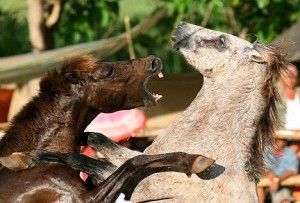






5 Worst States to be an Animal: Abuse Laws Lax
By Kim Thornton - 2/3/10 - NBC News
How can this be legal?

In live baiting, trainers trap piglets, kittens, bunnies and possums by the neck and get the greyhounds
to chase and eviscerate them. They call it "blooding" the dogs. Basically, they give the greyhounds
a taste of what it's like to kill and eat an animal so they will run faster during the race.
End Live Baiting in Greyhound Training - Sign Petition
Poaching

 If killing animals whose species are on the verge of extinction for profit's sake and not because they're a threat doesn't qualify as animal cruelty, I don't know what does. As far as I'm concerned, poachers of threatened and endangered species in Africa, Asia and elsewhere can rightfully be categorized as psychopaths. The criminal activity is not confined to individuals and small bands, although there is that, of course; poaching of this kind is mainly done by organized and well-funded international groups. There's a lot of money involved [one rhino horn can bring from 175,000 dollars to 350,000], and, besides the unfortunate fact that governments lack the will to forcefully go after poachers, it doesn't take a cynical eye to accept that in some cases officials and some rangers on the ground entrusted with protecting these endangered animals are bribed to look the other way. Plus locals, villagers who earn little, are easily enticed to help poachers.
If killing animals whose species are on the verge of extinction for profit's sake and not because they're a threat doesn't qualify as animal cruelty, I don't know what does. As far as I'm concerned, poachers of threatened and endangered species in Africa, Asia and elsewhere can rightfully be categorized as psychopaths. The criminal activity is not confined to individuals and small bands, although there is that, of course; poaching of this kind is mainly done by organized and well-funded international groups. There's a lot of money involved [one rhino horn can bring from 175,000 dollars to 350,000], and, besides the unfortunate fact that governments lack the will to forcefully go after poachers, it doesn't take a cynical eye to accept that in some cases officials and some rangers on the ground entrusted with protecting these endangered animals are bribed to look the other way. Plus locals, villagers who earn little, are easily enticed to help poachers.
It's a cold-hearted business and demand is intense in China, Viet Nam and other Asian markets where rhino horn is believed to have medicinal properties. And let's not forget the good ole U.S. of A., the second largest importer of elephant ivory in the world. If there were no markets, or ones of such low volume that they weren't worth the risk, that would certainly help, don't you think? Supply and demand.
H.R.2494: Global Anti-Poaching Act | Congress.Gov
Text of H.R.2494: Global Anti-Poaching Act | govtrack.us
H.R.2494: Global Anti-Poaching Act | House Committee on Foreign Affairs
Section-by-Section Summary | PDF File - House Committee on Foreign Affairs
H.R.2494: Global Anti-Poaching Act | Born Free USA
"Update (June 25, 2015): During markup in the House Committee on Foreign Affairs, a statement
of policy citing the value of trophy hunting to conservation efforts was added to the bill.
We can't support H.R. 2494 while it contains this language."
13 Scary Facts About Wildlife | Born Free USA
Elephant and Rhino Poaching | Network for Animals
"Africa is losing the battle to save its wildlife. Iconic African animals like elephants and rhinos
are under attack from highly organised criminal networks that are feeding an insatiable demand
for ivory and rhino horn in China, Vietnam and other Asian countries."
"In 2015, 749 rhinos have been killed so far (9/28/15) in South Africa"
-- AWF: African Wildlife Foundation
Rhino Horn: Knowledge vs. Superstition | Rhino Horn is NOT Medicine
"The Asian rhino species were nearly exterminated – for no other reason than their unfortunate
proximity to China and other East Asian countries that perpetuate medieval myths about rhino horn."
Suspicions Confirmed: China Investing Millions in Rhino Horn Scheme | June 2, 2011 - savingrhinos.org
How the Western Black Rhino Went Extinct | November 13, 2013 - Scientific American

Traditional Chinese Medicine and Endangered Animals | Encyclopedia Brittanica Advocacy for Animals
"TCM (Traditional Chinese Medicine) uses approximately 1,000 plant and 36 animal species, including the tiger,
rhinoceros, black bear, musk deer, and sea horse; the tiger, rhinoceros, and sea horse are endangered."
Endangered Tiger Facts | All About Wildlife
Species Directory - Status | WWF: World Wildlife Foundation
Species - Tiger
"Wild tiger numbers are at an all-time low. We have lost 97% of wild tigers in just over a century.
Tigers may be one of the most revered animals, but they are also vulnerable to extinction.
As few as 3,200 exist in the wild today."

Tigers
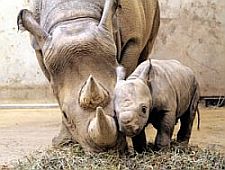

And what's with you trophy hunters?
Do you imagine you've validated your manhood, punched your Cro Magnon card, by shooting an animal with a high-powered rifle while hiding behind a clump of downed trees or bushes? Do you imagine you're on some kind of religious quest, a spiritual undertaking to find your earthly, authentic soul, doing your part to testify to Mankind's dominance over the lesser animals, joining the venerable society of tribal hunters? Or do you just like to kill things, especially animals that can kill you, let them know who's the top dog? Who's superior now, eh?
Lions and tigers are cats, they spend 16 hours a day sleeping and resting. Just sneak up on one, and from a safe distance, shoot while he/she's napping. What courage, what bravery, what narcissistic bullshit! Animals are not trophies.
Trophy Hunting in US Much Bigger and Horrible for Public Health and Conservation Than You Know | Free Speech TV
"African lion populations have been cut in half in the past 30 years.
Losses of habitat and prey are part of the problem, but shockingly,
American trophy hunters are responsible for hundreds of deaths per year."
--- HSI: Humane Society International ---
On Global Digest there is a sub-section on Trophy Hunting where you'll find info with pictures.

Dogs to be Spared Pesticide Poisoning Tests in Brazil | October 15, 2015 - HSI
Convention on International trade in Endangered Species of Wild Fauna and Flora | Leopard Quotas | CITES
PDF File | Sixteenth meeting of the Conference of the Parties Bangkok (Thailand), 3-14 March 2013
The total number of leopards currently (2013) allowed to be killed for sport in all of Africa comes to 2648.
Outlook is grim for mammals and birds as human population grows | June 19, 2013 - Science Daily
"There are an estimated 12 million species of plants and animals on earth, and the human
population exceeds 7 billion, with a gain of an estimated 214,000 people each day."
A basic attitude, a fundamental assumption, needs to change in the human psyche, an evolutionary leap of consciousness has to occur in each one of us, a realization that we humans and the rest of nature are in this together, whatever this is, what it all means, our collective purpose. Elsewise, living for ourselves alone will become not only a very lonely business indeed, but also a life where we'll have learned the ultimate function and supreme significance of ecology's role in maintaining and sustaining life on a global scale by the sense of all connections with nature gone, by the loss of real physical meaning in the world, and by a strange, discordant emptiness.
An attitude of contempt to the point of sadism towards other animals can only come back to bite us, eventually, if not immediately. That's an evolutionary path I don't want to see humanity go down. It's a direction, an offshoot, a way of seeing the world that, from its inception, has indelibly remained imprinted in Man's mind through history--responsible for many extinctions--while gaining strength in intensity of late, and, because of its human nature, resonates wider repercussions through society, informing expressions that, on the surface, may not be perceivable as having a direct connection. The ripples fan out and permeate, by osmosis, if nothing else.
In spite of what we know, we accept things as they are--humankind's interacting relationships with the natural world--because, even at its worst, we can dismiss it with it's the nature of the beast, and focus on our own personal lives. Even as we may find cruelty to animals repugnant and immoral--cruelty in general, for that matter--somewhere in our reptilian brain we feel obligated and honor-bound to validate this mode of being, a natural, deeply-ingrained way that kept Mankind going through the ice-age and before. But is that true? How much did cooperation with the natural order and empathy with the other inhabitants of planet Earth play a part in Man's survival?
The root of cruelty stems from somewhere. Perhaps in former times and among certain cultures--prehistory--it manifested as justifiable cold-hearted ruthlessness when it came to hunting, an 'us' verses 'them' mentality. But there are cultures where just the opposite is true; Native Americans, for instance; the tribes of Eastern Siberia, all guided by shamans, people in touch with nature. But, in either case, if we peel the cultural skin back, when the precursors of humanity first stood to walk through the high grass, they probably did not receive predators with kindness. However, that inner willfulness and unconditioned aggression, always potentially present as our legacy, have taken on an ugly twist in our current [last 10,000 years] relations with other animals, and seems to be accelerating in that direction more recently. On the one hand, pleasure is associated with it, the crueler forms of what passes for entertainment especially, and on the other, a rational acceptance of its need, distancing us from any moral-bound inference.
On a deeper level still, however, we mustn't overlook the possibility that Earth has its own agenda, and there may come a time--if it's not already in the works--when we humans are seen and judged as a destructive virus that needs to be eliminated, for the health of the whole.
 |
 |
 |
| Click image for larger version. |

Global Digest has an extensive and comprehensive section on: Animal Cruelty -- Animal Testing.











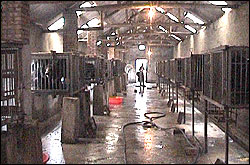


 ||
||  ||
||  ||
||













 "Animal testing at UW has been commonplace for years. The approved, $123 million animal research facility will accommodate 10 percent more rodents and 20 percent more rabbits, pigs and primates. Medical training is not more advanced with animal testing; in fact, it is less accurate than other, non-abusive training."
"Animal testing at UW has been commonplace for years. The approved, $123 million animal research facility will accommodate 10 percent more rodents and 20 percent more rabbits, pigs and primates. Medical training is not more advanced with animal testing; in fact, it is less accurate than other, non-abusive training."
 We have laws on the books against cruelty to animals, and yet 100 million animals per year are used for experimentation worldwide. Beyond that, dog fighting and bear baiting (tormenting) continue as entertainment pursuits of the cruel and sadistic, those whose empathy mechanism is broken. In rural Pakistan, up to 2,000 spectators will assemble to watch a toothless and clawless bear set upon by trained fighting dogs [as many as 300 in rapid succession at some events] bite and tear at a helpless bear tethered to the ground. I've seen pictures of people in the stands, they're smiling, obviously enjoying themselves. What the hell is wrong with these people?
We have laws on the books against cruelty to animals, and yet 100 million animals per year are used for experimentation worldwide. Beyond that, dog fighting and bear baiting (tormenting) continue as entertainment pursuits of the cruel and sadistic, those whose empathy mechanism is broken. In rural Pakistan, up to 2,000 spectators will assemble to watch a toothless and clawless bear set upon by trained fighting dogs [as many as 300 in rapid succession at some events] bite and tear at a helpless bear tethered to the ground. I've seen pictures of people in the stands, they're smiling, obviously enjoying themselves. What the hell is wrong with these people?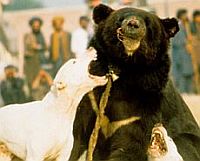



 |
|  |
| 








 If killing animals whose species are on the verge of extinction for profit's sake and not because they're a threat doesn't qualify as animal cruelty, I don't know what does. As far as I'm concerned, poachers of threatened and endangered species in Africa, Asia and elsewhere can rightfully be categorized as
If killing animals whose species are on the verge of extinction for profit's sake and not because they're a threat doesn't qualify as animal cruelty, I don't know what does. As far as I'm concerned, poachers of threatened and endangered species in Africa, Asia and elsewhere can rightfully be categorized as 








